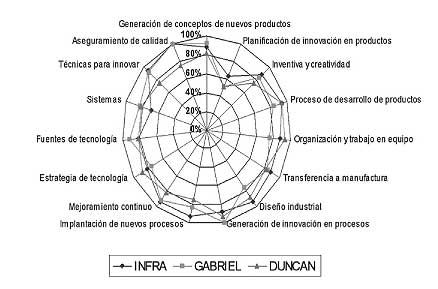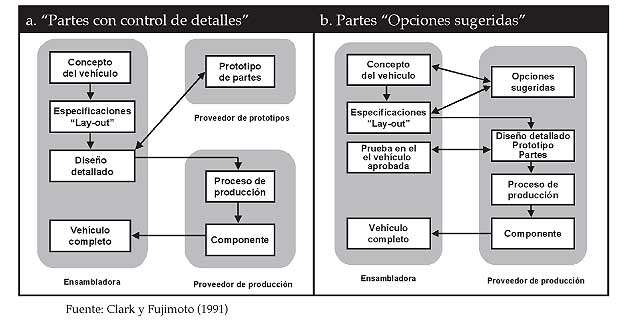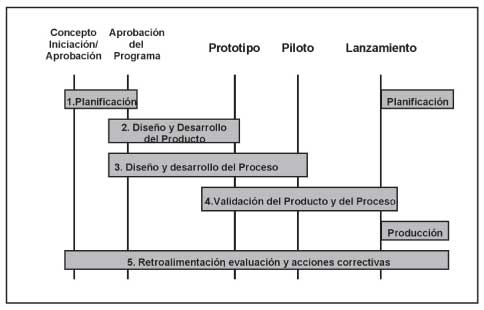Cervilla, M.A. (2004): “Innovación, aprendizaje y capacidades estratégicas en empresas del sector de autopartes: Un estudio de casos”, Trabajo presentado para optar al grado de Doctor en Estudios del Desarrollo, CENDES, UCV.
Chiesa, V., Coughlan, P. y Voss, C. (1996) “Development of a Technical Innovation Audit”, Journal of Production and Innovation Management, 2 (2), 105-136.
Clark, K. B. y Fujimoto, T. (1991): Product Development Performance, HBA Press, Boston, MA.
Cooper, R.G. (1993): Winning at New Products; Accelerating the Process from Idea to Launch, Reading, Addison-Wesley, MA.
Cooper, R. (1994) “Perspective: Third-Generation New Product Processes”, Journal of Product Innovation Management, 11, 3-14.
Cooper, R.G. (1999) “From Experience: The Invisible Success Factors in Product Innovation”, Journal of Product and Innovation Management, 16, 115-133.
Cooper, R.C. y Edgett, S.J. (1996) “Critical Success Factors for New Financial Services,” Marketing Management, 5 (3), 26-37.
Cooper, R. y Kleinschmidt, E. (1995): New Products: The key factors in success, American Marketing Association, Chicago.
Griffin, A. (1997) “Drivers of New Products Success: The 1997 PDMA Report”, IL: Product Development and Management Association, Chicago.
Hertenstein, J.H. y Platt, M.B. (2000) “Performance measures and management control in new product development”, Accounting Horizons, 14 (3), 303-323,
Hustad, T.P. (2002) “Reviewing current practices in innovation management and a summary of selected best practices”, en Griffin, A., Belliveau, P. y Somermeyer, S., eds., The PDMA toolbox for New Product Development , John Wiley & Sons, New York.
Leonard, D. (1995) Wellsprings of Knowledge: Building and sustaining the sources of innovation, Harvard Business School, Boston.
Malavé, J. (1999) Prácticas organizacionales: Una perspectiva de procesos en la teoría de la organización, Ediciones IESA, Caracas.
Mc Kee, D. (1992) “An Organizational Learning Approach to Product Innovation”, Journal of Product Innovation Managing, 9, 232-245.
Nelson R. y Winter, S. (1982) An evolutionary theory of economic change, Belknap Press, New York.
Pavitt, K. (1998) “Technologies, Products and Organization in the Innovating Firm: What Adam Smith Tell Us and Joseph Schumpeter Doesn’t”, Industrial and Corporate Change, 7, 433-51.
Pavitt, K. (2002) “Innovating routines in the business firm: what corporate task should they be accomplishing?, Industrial and Corporate Change, 11 (1), 117-133.
Roussel P., Saad, K. y Erickson, T. (1991): Third Generation R&D, HBA Press, Boston, MA.
Pisano, G. (2000) “In Search of Dynamic Capabilities: The Origins of R&D Competence in Biopharmaceuticals”, en G. Dosi, R. Nelson y S. Winter (eds.), The Nature and Dynamic of Organizational Capabilities, Oxford University Press, Londres.
Slack, N. y M. Lewis (2003): Operations Strategy, Pearson Education, Inc., New Yersey.
Tidd, J. (2001) “Innovation management in context: environment, organization and performance”, International Journal of Management Reviews, 3 (3), 169-183.
Tidd, J., Bessant, J. y Pavitt, K. (1997) Managing Innovation: Integrating Technological, Market and Organizational Change, John Wiley & Sons Ltd. 2nd Edition 2001.
Von Hippel, E., S. Thomke, M. Sonnak (1999) “Creating Breakthroughs at 3M”, Harvard Business Review, Sep-Oct., 47-57.
Anexos


